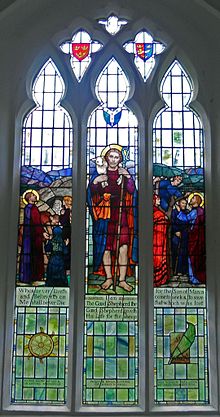Joan Howson
Joan Howson | |
|---|---|
 Stained glass window, Pettaugh, Suffolk by Caroline Townshend and Joan Howson | |
| Born | 1885 Flintshire, Wales |
| Died | 1964 (aged 78–79) |
| Nationality | British |
| Alma mater | Liverpool School of Art |
| Known for | Stained glass |
Joan Howson (1885–1964) was a British stained glass artist of the Arts and Crafts movement. She trained at the Liverpool School of Art before becoming a student and apprentice to Caroline Townshend. They later developed a lifelong partnership creating stained glass works under the name of their company, Townshend and Howson.
Personal life[]
Howson was born 9 May 1885 in Flintshire to Ethel and George John Howson, MA. George Howson attended Trinity College at Cambridge and was an Archdeacon. Ethel's father was the Archdeacon Dealtry and Vicar of Maidstone. Joan Howson had four older brothers, one of whom died as a baby.[1][2][3] Her brother George served in the First World War and later became chairman of the Royal British Legion's Poppy Factory.
She was involved in the woman's suffragette movement and socialism.[3]
Biography[]
Howson trained at the Liverpool School of Art from 1909 to 1912. She also studied music in Paris.[3] After completing her training at Liverpool School of Art, Howson met Caroline Townshend at The Glass House studios in London. Howson became a student and apprentice to Townshend in 1912.[2][4]
In 1920 they began their partnership, Townshend & Howson, under which they obtained commissions; they signed their works joining both of their initials. Then they moved to Putney where they had converted a house to serve as a studio and workshop, and were neighbours to Edward Woore and other stained glass artists.[2][3][4]
Townshend died in 1944. Howson returned to Putney and resumed her work there, often restoring medieval glass. She maintained both her late partner's initials and name in the company business. Two of her notable commissions were for Oxford University with the Department of Medieval Art, and a commission for the Church of St Mary Magdalene in Newark-on-Trent restoring stained glass from the 14th century.[2][3][4]
The Archdeacon of Suffolk donated a box of medieval glass fragments from Combs church, Suffolk, the result of an 1871 explosion, to the Victoria and Albert Museum. Howson was given the fragments to reassemble in 1939 and carried out the work without charge. During World War II the box of glass was taken to safety in a Portmadoc, North Wales mine. After the war ended, she received the retrieved fragments but it would be several years before she resumed work on the project, which she completed in 1952; the results were installed in the southeast windows of the church.[5] Meanwhile, an important restoration commission was for Westminster Abbey, to restore windows damaged during the war; she worked on this with Mary Eily de Putron.
Gallery[]


References[]
- ^ Farrer, Archdeacon William. (1894). The descendants of John Backhouse, yeoman, of Moss Side. Volume 1 London: Chiswick Press. (private printing). p. 64.
- ^ a b c d Joan Howson. University of Wales: Gwydr Lliw yng Nghymru – Stained Glass in Wales. Retrieved 8 August 2012.
- ^ a b c d e Joan Howson. Archived 2 April 2012 at the Wayback Machine Sussex Parish Churches: Architects and Artists H. Retrieved 19 August 2012
- ^ a b c Caroline Townshend. Archived 26 September 2010 at the Wayback Machine Sussex Parish Churches: Architects and Artists T-U-V. Retrieved 19 August 2012
- ^ History – Stained Glass St Mary's Church Combs. Retrieved 20 August 2012.
Further reading[]
- Putron, M. E. de. (1976–77). Journal of the British Society of Master Glass-Painters. 16:1. pp. 46–54. Article about stained glass and Joan Howson.
- Eavis, Anna. Panel of the Month – Including Howson's work. Vidimus: Online Medieval Glass Magazine, Issue 16.
- St Mary's Church Combs – History – Stained Glass – short article about Howson's work restoring medieval glass
- Westminster Abbey – reparations of stained glass by Howson following World War II
- 1885 births
- 1964 deaths
- 20th-century British women artists
- People from Flintshire
- Alumni of Liverpool John Moores University
- British stained glass artists and manufacturers